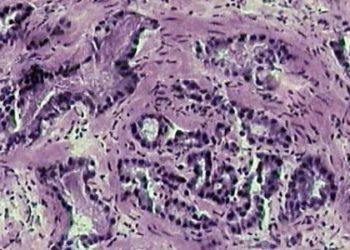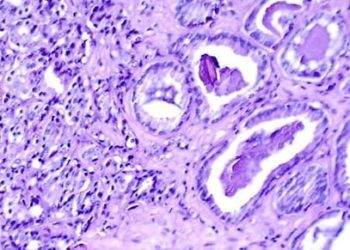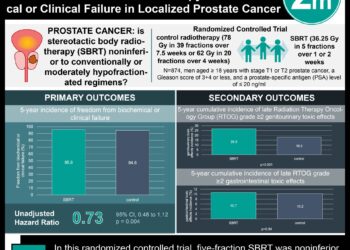Endostatin directly binds androgen receptors to treat prostate cancer [PreClinical]
1. Endostatin (ES), a drug commonly studied and applied for its inhibition of tumor blood vessel growth (termed angiogenesis), decreased proliferation of androgen-receptor (AR) positive prostate cancer (PC) cells in culture.
2. ES was shown to directly bind to AR in a manner suggested to evade the common problem of acquired tumor resistance to androgen deprivation therapy (ADT).
Evidence Rating Level: 2 (Good)
Study Rundown: At tens of thousands of deaths per year, PC remains a leading cause of mortality in men in the United States. PC malignancy depends on altered AR activity, which is usually treated by lowering the levels of hormones (androgens) required for AR function (termed ADT). However, prostate tumors often acquire resistance to this approach, and resume AR function in castration-resistant prostate cancer (CRPC). This transformation to androgen-independence necessitates the need to identify AR-targeted therapies that reliably antagonize the receptor activity.
Although ES is largely studied for its anti-angiogenesis effects, the researchers in this study hypothesized that structural similarities between ES and AR might reflect a direct role for ES in AR targeting. They showed that ES significantly slowed growth of PC cells containing ARs, including an androgen-independent cell line. ES resulted in altered expression of various genes normally regulated by AR function, demonstrating an AR-dependent effect. AR levels were significantly lowered in cells treated with ES. Direct interaction between ES and AR was demonstrated by the presence of AR in the ES-containing component of PC cell lysate, which was isolated using ES-specific antibodies. The ES-AR interaction was decreased when the AR AF-2 domain was established, which showed ES specifically binds to this domain.
ES has already been studied as an anti-cancer therapeutic, thus fewer studies are needed than those for a novel drug to evaluate the drug’s potential in human medicine. A recent study by the authors of this work previously showed ES slowed PC growth in mice. The therapeutic potential of ES for treating CPRC, possibly in combination with approved chemotherapies, should be evaluated in animal models.
Click to read the study in PNAS
Relevant Reading: Androgen receptors in hormone-dependent and castration-resistant prostate cancer
In-Depth [in vitro study]: ES concentrations of 0.5 and 1 µM decreased cell growth (p<0.05) in LNCaP cells, which are androgen-dependent, and C4-2B cells, which are androgen-independent. Immunocytochemistry and immunoblotting showed decreased levels of the proteins regulated by AR target genes prostate-specific antigen and transmembrane protease serine 2 in LNCaP cells in the presence of 1 µM ES (p<0.05 and p<0.01, respectively), and RT-PCR showed decreased mRNA expression levels for both genes (p<0.01). ES increased prostatic acid phosphatase mRNA expression (p<0.01), which is normally repressed by AR. Biotinylated ES demonstrated high, mainly cytoplasmic localization in LNCaP cells, and had lower affinity for PC3 PC cells lacking AR. Subcellular fractionation followed by immunoblotting showed that ES treatment lowered AR levels in the nucleus by 70% (p<0.05), and total AR levels by 86% (p<0.01).
AR ligands, which normally stabilize AR function, did not reverse the decreased cell growth seen with ES treatment. This observation coupled with the ES-mediated growth decrease of androgen-independent C4-2B cells suggested a direct interaction between ES and AR. ES incubated with LNCaP lysate showed coimmunoprecipitation of AR with ES. This result was echoed by chromatographic coelution of the two compounds, as well as a yeast-two hybridization assay.
Structural analysis suggested that ES binds the AR AF-2 domain within the ligand-binding domain (LBD). Blocking AF-2 resulted in decreased AR binding to ES (p<0.05), an effect that was increased when only the AR LBD was studied (p<0.01). Finally, two single ES residues were identified as critical for AR binding. Mutant ES containing amino acid substitutions at these locations failed to bind to AR, and did not decrease PC cell growth.
More from this author: Fluorophores enhance visualization for image-guided surgery, Engineered stem cells mitigate liver damage caused by radiation, Injectable loaded microparticle scaffolds improve vaccine responses in mice, Nanoparticles may reduce impact of neurological injury, Cholesterol-containing lipid particles protect mice from lethal bacterial toxins
Image: PD
©2015 2 Minute Medicine, Inc. All rights reserved. No works may be reproduced without expressed written consent from 2 Minute Medicine, Inc. No article should be construed as medical advice and is not intended as such by the authors, editors, staff or by 2 Minute Medicine, Inc.




![Active smoking cessation intervention may provide tangible results [Project CLIQ]](https://www.2minutemedicine.com/wp-content/uploads/2014/12/smoking-e1418644951268-75x75.jpg)

